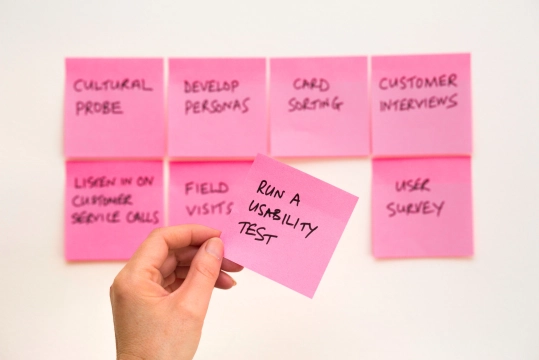User experience (UX) research is an essential factor to solve problems when developing a product. In other words, it’s a research phase, during which you analyze your target groups, users’ behaviours and their motivations, evaluate your solutions to contribute a product design and its strategy. Implementing various research methods during this process, such as i.a. interviewing prospective users, or doing usability tests, enables to identify product assumptions and requirements.
When you are preparing to implement a new product or you are just trying to uncover possible drawbacks in your project, there are many things to consider. User research, visual design, information architecture, usability, content, and much more, help you to create an optimal product for prospective users.
Benefits and importance of UX research
User research allows us to understand user behaviours, needs and expectations through methodical approach, providing information such i.a. how people perform tasks and achieve goals which are important for them, what problems and fears they have, or what confuses them, and so on. The data, gained during research, helps us to make productive design decisions and avoid unwarranted or wrong project assumptions.
On the other hand, skipping user research may cause serious consequences for a product. Just imagine spending loads of time and money, involving all of your teams on making a product that nobody wants to use. Well..., but how you could know if product solves users needs - if you didn’t spend time to understand their problems?
Here are more reasons, why you should include UX research in your product-development cycle. User research:
-
allows to learn about competitors offer;
-
validates early hypotheses and product assumptions;
-
allows to identify early users, their needs, expectations and fears;
-
allows to create products valuable and efficient for users;
-
helps to understand the return of investment (ROI) of UX design.
Methods
UX research covers a great range of various methods you can apply throughout different phases of product cycle, including analysis of competitors and target groups, surveys and questionnaires, creating personas and scenarios, empathy mapping, journey mapping, but also evaluation UX techniques, such as A/B testing, or usability testing. Each method can be used in achieving different objectives, obviously -depending on requirements and constraints of your project. But keep in your mind, that choosing and applying an appropriate research technique puts you one step closer to create a high-quality product, which meets user expectations.

If there are tight time and budget constraints, instead of skipping a comprehensive UX research, consider applying some of the following research methods:
-
Lean UX - design and provide solutions in the form of Minimum Viable Product (MVP);
-
Guerrilla research - do some user researches and interviews, which provide you great insights about perspective users and your product;
-
Heuristic evaluation - study user interface and evaluate its compliance with the heuristics list to uncover and fix usability problems early;
-
Hypothetical personas - instead of creating personas based on actual audience data, create hypothetical personas basing on reasonable assumptions.
Conclusion
Every business and product strategy should keep the target group and its needs in mind. And here is the role of UX research which ensures the user stays at the center of whole development process, at the same time subordinating product’s design and its usability to the user. By implementing effective and appropriate user research methods you can make right decisions basing on the contribution of actual users, leading you to create an optimal product fully meeting users needs and providing valuable user experience.
Newsletter
No spam - only valuable content!: